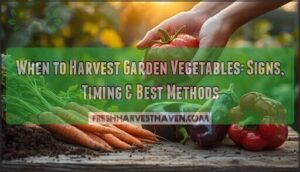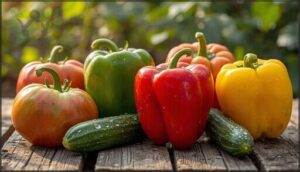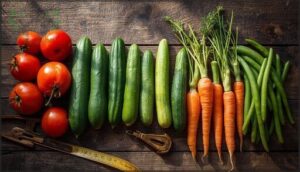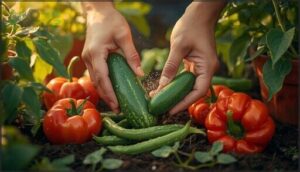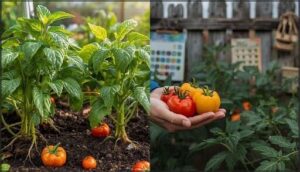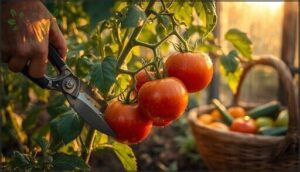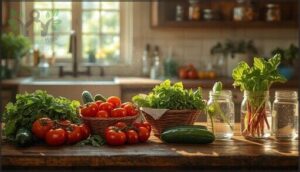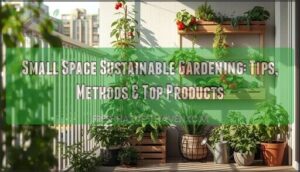This site is supported by our readers. We may earn a commission, at no cost to you, if you purchase through links.
You check your tomatoes every morning but they still go from hard to split overnight. Or you pull carrots that looked ready but taste woody and bitter. Timing harvest right feels like guesswork until you learn what to look for.
Most gardeners lose flavor and texture by picking too early or waiting too long. The difference between bland and sweet often comes down to a single day.
Your vegetables send clear signals when they hit peak ripeness. Color shifts. Texture changes. Even the time of day matters more than you’d think. Learning to read these signs transforms your harvest from hit-or-miss into consistent quality that actually tastes like something.
Table Of Contents
- Key Takeaways
- When to Harvest Garden Vegetables
- Visual and Physical Signs of Vegetable Readiness
- Factors That Influence Harvest Timing
- Best Harvesting Techniques for Each Vegetable
- Post-Harvest Care and Storage Tips
- Frequently Asked Questions (FAQs)
- When should vegetables be harvested?
- When should you pick fruits & vegetables?
- How often do you harvest vegetables?
- How do you harvest vegetables?
- What vegetables can you harvest in fall?
- How do you pick a vegetable if it’s not ready to pick?
- How do I know when my veggies are ready to pick?
- Should you till your vegetable garden in the fall?
- What is the harvest time for vegetables?
- How to keep garden veggies fresh all winter?
- Conclusion
Key Takeaways
- Harvest timing depends on visual cues like color shifts and texture changes rather than calendar dates, with tomatoes gaining 1.5–3.5 Brix units of sugar as they ripen and carrots increasing beta-carotene by 25–40% in their final weeks.
- Daily morning checks catch the narrow 1–3 day peak ripeness window and boost harvest success by 18–28%, preventing vegetables from turning oversized, woody, or bitter.
- Proper harvesting technique matters as much as timing—support fruit with one hand while cutting stems cleanly with sharp pruners to avoid plant damage and ensure continuous production.
- Immediate post-harvest cooling within 1–2 hours and proper storage methods like refrigeration at 3–4°C or blanching before freezing can extend freshness from days to months while preserving flavor and nutrients.
When to Harvest Garden Vegetables
Knowing when to pick your vegetables makes all the difference between bland and bursting with flavor. The secret isn’t just watching the calendar—it’s reading the signs your plants give you every day.
The secret to flavor-packed vegetables isn’t watching the calendar—it’s reading the signs your plants give you every day
Let’s break down how to spot peak ripeness and why timing matters so much for taste.
Recognizing Peak Ripeness by Vegetable Type
You won’t guess ripeness the same way for every vegetable. Tomatoes need a rich red color and slight give after 65–75 days from flowering. Peppers turn yellow or red at 60–90 days when sweetness peaks.
Carrots deepen to orange as carotenoids double over their final weeks. Snap beans hit ideal harvest at just 4–6 cm with crisp pods that snap cleanly when bent.
Effects of Maturity on Flavor and Texture
Timing your harvest locks in peak flavor and texture. Sugar content in tomatoes climbs by 1.5–3.5 Brix units as they shift from green to red. Carrots sweeten as beta-carotene jumps 25–40% in their final weeks. Harvest timing shapes these ripening processes:
- Early picking yields crisp but bland vegetables
- Peak maturity delivers balanced sweetness and texture
- Overripe crops turn mushy or bitter
- Morning harvest captures peak hydration for crunch
- Late harvest reduces soluble sugar levels
You control flavor profiles through maturity stages.
How Daily Checks Improve Harvest Timing
Daily checks catch that tight 1–3 day peak window when most vegetables hit maximum ripeness. You’ll boost harvest success by 18–28% with routine morning inspections. Zucchini and cucumbers shift fast—miss a day and they’re oversized.
Track patterns in a garden journal or use harvest timing apps to predict readiness. Daily monitoring cuts post-harvest weight loss by 10–20% across tomatoes and peppers while shortening your overall harvest cycle by 2–5 days.
Visual and Physical Signs of Vegetable Readiness
Your vegetables will tell you when they’re ready if you know what to look for. Each crop sends out its own signals through color shifts and physical changes that you can see and feel.
Let’s walk through the three main cues that help you nail the perfect harvest every time.
Color Changes as Ripeness Indicators
Color changes are your most reliable visual cues for vegetable harvesting. When tomatoes shift from green to deep red, they’ve reached peak flavor with Brix levels around 6.0–6.5. Peppers shifting from green to red or yellow signal higher sweetness and vitamin content. Cucumbers darken from pale yellow-green to deep green at ideal firmness. These color shifts in fruit pigments directly correlate with ripeness stages and harvest timing for peak flavor.
Size and Shape Guidelines for Common Crops
Fruit diameter and root girth give you concrete harvest timing benchmarks across crop size variations. Here’s your vegetable harvest guide with shape guidelines and ripeness signs tied to vegetable maturity:
- Tomatoes: Cherry types ready at 25–30 mm diameter; globe varieties at 60–70 mm with 75–85% color
- Cucumbers: Slicing types at 15–25 cm; pickling at 8–12 cm with uniform shape
- Carrots: Root diameter 1.5–2.5 cm near crown signals vegetable harvesting time
- Green beans: Harvest at 12–15 cm length matching days to maturity expectations
Using Texture and Aroma to Judge Maturity
Firmness tests and aroma analysis work together to pinpoint harvest timing with real precision. Press gently on beans or cucumbers—you’ll feel a 15–40% drop in firmness as they shift from mature to overripe.
Texture changes pair with stronger scent: ripe tomatoes and peppers release up to triple the aroma volatiles at peak flavor.
These maturity signs guide your ripeness decisions better than calendar dates alone.
Factors That Influence Harvest Timing
You can’t just circle a date on the calendar and expect your vegetables to be ready. Harvest timing shifts based on conditions you can control and ones you can’t.
Let’s break down the three main factors that speed up or slow down when your crops reach peak ripeness.
Climate and Weather Impacts on Harvest Dates
Temperature fluctuations can shift your harvest windows by days or even weeks. Warmer springs accelerate growth in leafy greens, and you might harvest 5–10 days earlier than usual. Late frosts threaten young crops.
Watch night temperatures during fruit set—peppers and tomatoes suffer when nights exceed 15°C. Climate shifts expand frost-free periods but bring new risks.
Check forecasts daily and adjust your seasonal harvesting plans accordingly.
Soil Quality, Water, and Sunlight Effects
Your soil quality sets the foundation—organic matter above 3% firms up tomatoes by 8%, while pH between 6.0 and 6.8 speeds lettuce emergence by 12–18%. Soil moisture at field capacity cuts fruit drop in tomatoes by 15–20%, but over-watering triggers blossom-end rot in peppers.
Water stress during fruit fill shrinks cucumber yields by 14–21%.
Sunlight exposure above 12 mol/m²/day extends your leafy green harvest window by 3–5 days. Soil temperature between 18–24°C shortens time to first harvest.
Role of Variety and Maturity Rates in Harvest
Your variety selection directly determines harvest timing and flavor profile. Early-maturing types pack 12–20% higher sugar at peak ripeness than late-season picks. Indeterminate tomatoes hit flavor intensity 7–14 days after first true leaf flush.
- Choose varieties with synchronized maturity to trim harvest passes by 25–40%
- Match days to maturity with your growing window for consistent crop yield
- Early varieties concentrate sugars faster under identical irrigation
- Uniform maturity boosts per-plant yield by 8–15% through fewer skipped cycles
Crop management starts with smart variety selection and maturity rates—your vegetable harvesting guide begins at seed selection.
Best Harvesting Techniques for Each Vegetable
Knowing when to harvest is only half the battle. The way you actually pick your vegetables matters just as much as timing.
Let’s walk through the best techniques for each type so you can protect your plants and get the highest quality produce.
Proper Methods for Leafy Greens, Roots, and Fruit Vegetables
Each crop demands its own approach to avoid damage and preserve quality.
For leafy green harvest, cut or pinch individual outer leaves at the base—this keeps the plant producing for weeks.
Root vegetable care requires loosening soil with a fork before pulling to prevent snapping.
With fruit ripening tips in mind, support tomatoes and peppers with one hand while cutting stems cleanly with the other to protect both plant and produce.
Essential Tools for Damage-Free Harvesting
Sharp pruning shears and harvest shears give you clean cuts without crushing stems—controlled trials show spring-loaded pruning tools reduce plant tissue damage by 40%. You’ll also want garden knives or a harvesting knife for leafy greens and a sturdy spading fork or broadfork to lift roots without snapping them. Round out your crop handlers with padded harvest baskets that cut fruit bruising by 33%.
- Bypass pruners for stem-only cuts on tomatoes and peppers
- Serrated harvest knives paired with soft-touch gloves for tender leaves
- Terminal shears with curved blades for vine crops
- Padded harvest baskets to protect delicate fruits during collection
Tips for Gentle Handling and Continuous Picking
Gentle picking makes all the difference. Support each fruit with one hand while you cut with the other—this downward motion cuts wound sites and keeps plants producing. Rotate your picking spots across beds to spread stress evenly. Check fast growers like beans and cucumbers every other day so nothing gets oversized.
Here’s how different crops respond to picking pressure:
| Crop Type | Picking Frequency | Handling Priority |
|---|---|---|
| Leafy greens | Every 3–5 days | Minimize leaf bruising |
| Vine crops | Every 1–2 days | Support fruit during cut |
| Root vegetables | As needed | Gentle crown loosening |
| Fruiting plants | Every 2–3 days | Downward twist motion |
Staggered harvest rotation encourages continuous production, while damage reduction through proper postharvest handling preserves your fresh produce for days longer.
Post-Harvest Care and Storage Tips
You’ve put in the work to grow and harvest your vegetables at their peak. Now you need to handle them right so all that flavor and freshness doesn’t disappear in a day or two.
Here’s how to cool, store, and preserve your harvest so it lasts as long as possible.
Immediate Cooling and Cleaning Practices
Cool your harvest down within an hour or two to lock in flavor and crispness. Rapid cooling slows spoilage and cuts microbial reduction by more than half in leafy greens.
Rinse off dirt with debris removal before chilling—sanitizing rinses with 50–100 mg/L chlorine drop surface bacteria without harming taste.
Temperature control and gentle postharvest handling protect your hard-earned produce.
Short- and Long-Term Storage Solutions
Once everything is rinsed and chilled, the right storage setup can stretch freshness for weeks. Here’s how to handle short- and long-term food storage:
- Refrigerate leafy greens at 3–4°C in perforated plastic or paper bags—this cooling method adds 1–2 weeks of shelf life and controls humidity around 60–70%.
- Store root crops in breathable containers to prevent wilting for up to 8 weeks.
- Blanch before freezer storage to lock in color and nutrients for 12 months of freshness retention.
Preserving Excess Produce for Extended Freshness
Abundance turns into action when you freeze, can, or dry your haul. Freezing methods like blanching snap peas lock enzymes at bay. Canning tips center on hot-water baths for high-acid foods. Dehydration techniques preserve herbs at 35–45°C.
Pickling recipes add tang while extending storage 6–12 months. Vacuum sealing cuts freezer burn.
Master these food preservation strategies and your harvest method pays off season after season.
Frequently Asked Questions (FAQs)
When should vegetables be harvested?
Your garden whispers secrets about harvest timing through color shifts and texture changes. Watch for glossy cucumber skin and firm tomato shoulders.
Most crops hit peak ripeness 50–90 days after sowing when vegetable readiness signals align.
When should you pick fruits & vegetables?
Pick fruits and vegetables when they reach peak ripeness. Look for color changes, firmness, and aroma. Early morning harvesting delivers the best flavor and texture, maximizing crop maturity and quality.
How often do you harvest vegetables?
Like checking your mailbox daily for important letters, your harvest frequency depends on the crop. Fast growers like zucchini need picking every day or two. Slower vegetables like winter squash can wait weeks between checks.
How do you harvest vegetables?
Use sharp pruners or shears for clean cuts on tomatoes and peppers. Support fruit with one hand while cutting.
For root crops, loosen soil with a fork before pulling gently to avoid damage.
What vegetables can you harvest in fall?
Cool weather brings your best autumn vegetables: carrots, kale, Brussels sprouts, and winter squash all thrive. These fall crops handle light frost beautifully, developing sweeter flavors as temperatures drop—perfect for seasonal harvesting strategies and extended vegetable storage through winter months.
How do you pick a vegetable if it’s not ready to pick?
You don’t pick unripe vegetables. Wait until they show proper ripeness indicators—color, size, texture—through daily crop monitoring. Premature picking sacrifices flavor and yield.
Gentle plucking at true harvest time using correct harvesting techniques ensures quality produce.
How do I know when my veggies are ready to pick?
Your veggies signal ripeness through color shifts and size. Check daily for glossy peppers or bright green beans. Texture matters too—firm carrots and crisp cucumbers tell you it’s harvest time.
Understanding content strategy basics can help gardeners create informative guides.
Should you till your vegetable garden in the fall?
Fall tilling benefits your vegetable garden by breaking up compacted soil and reducing overwintering pests by up to 40%. Wait until after the first hard frost for best results.
Autumn maintenance gets beds ready for early spring planting.
What is the harvest time for vegetables?
Most vegetables reach harvest maturity based on the days to maturity listed on seed packets. Crop monitoring and harvest timing depend on variety, climate, and garden planning.
Leafy greens usually need 25–60 days, while root vegetables require 70–90 days.
How to keep garden veggies fresh all winter?
Think of your harvest like building a pantry fortress.
Store root crops in cool root cellars. Freeze blanched vegetables for nutrition preservation. Can acidic produce.
Dehydrate herbs using proper food preservation techniques for winter storage success.
Conclusion
Perfect timing turns plants into plates worth remembering. You’ve learned when to harvest garden vegetables by reading color shifts and texture changes instead of guessing dates on packets.
Your morning checks now catch that single day between bland and exceptional. Pick early for crunch or wait for sweetness. Either way, you’re working with signals the plant already sends.
Walk out tomorrow and trust what you see. Your harvest timing just became your strongest skill.
- https://amberstudent.com/blog/post/research-topics-for-students
- https://warren.cce.cornell.edu/gardening-landscape/warren-county-master-gardener-articles/fall-planting-for-the-vegetable-garden
- https://www.sciencedirect.com/science/article/pii/S0260691723000977
- https://dictionary.cambridge.org/dictionary/english/subtopic
- https://files.eric.ed.gov/fulltext/ED536788.pdf

